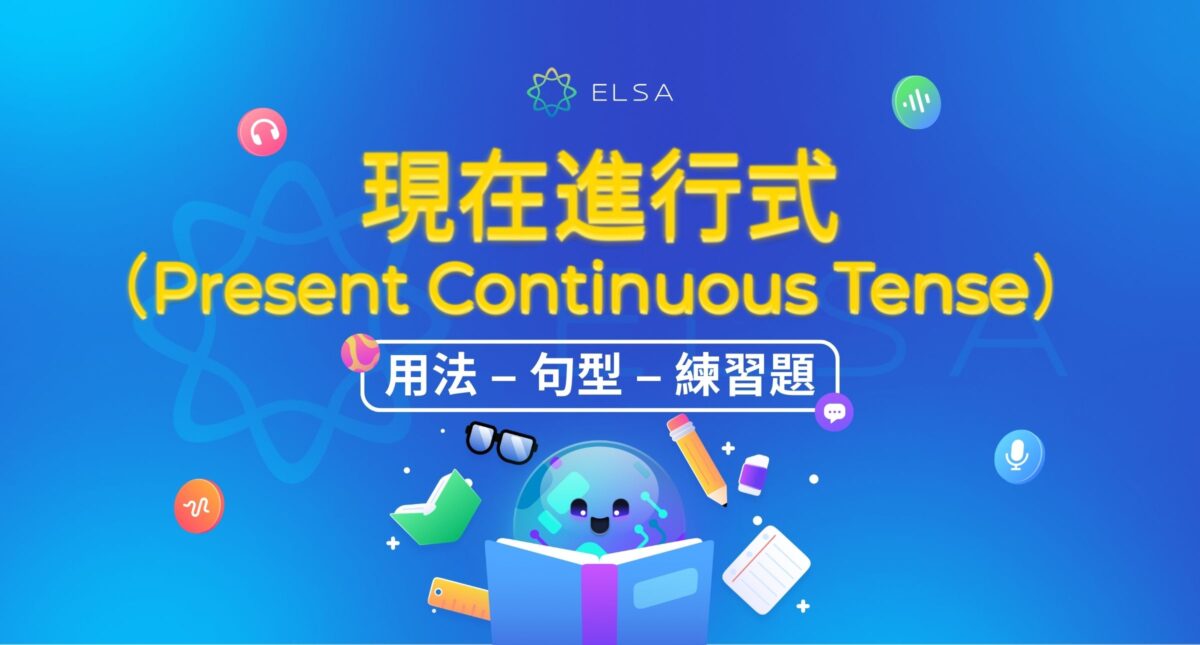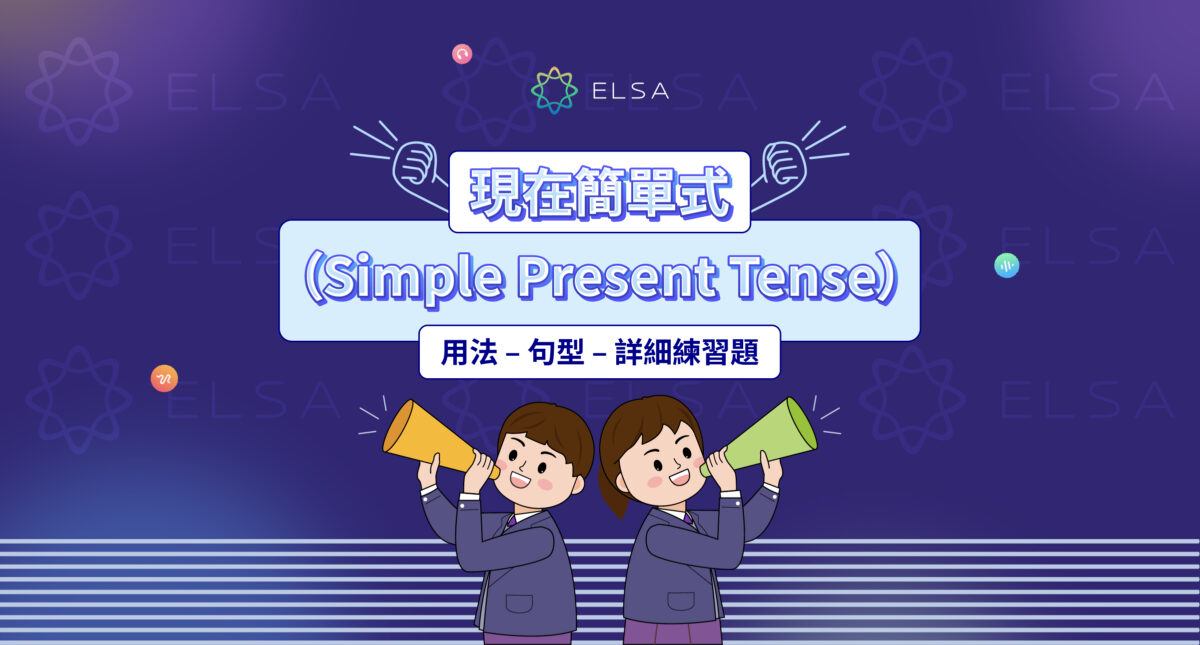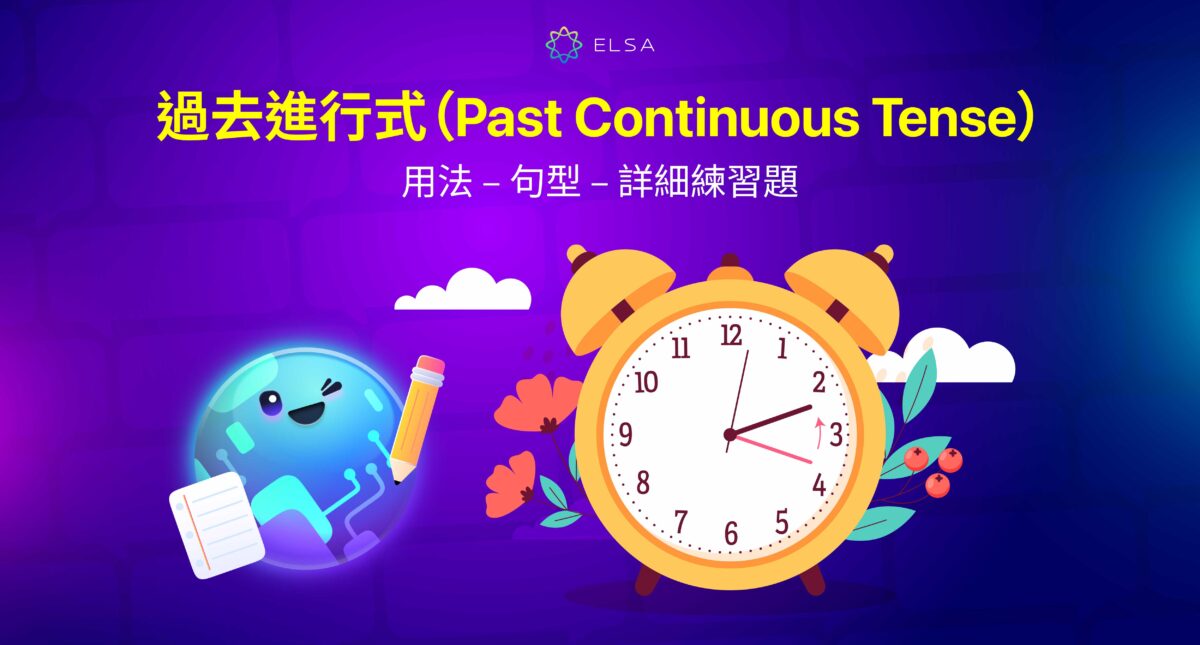動詞三態是英文書本上極度熟悉的表示動詞形式的知識,在學習過程中用到的很多。與 ELSA Speak一起學習動詞三態的用法以便可以準確流利地使用英語!
需要牢牢掌握動詞三態知識的原因
- 正確使用動詞時態:英文時態分為三種主要類型:現在式、過去式和將來式。每種時態都有不同的動詞形式。
- 為了理解句子的意思:英語中,句子的意思可以根據所使用的動詞形式而改變。例如,在 “I went to the store yesterday”這句話中,動詞「went」是簡單過去形式,表達過去發生的動作。
- 有效溝通:正確使用動詞和理解句子的意思是幫助您用英語有效溝通的兩個重要因素。如果您不清楚三態動詞,你將難以溝通,導致誤解或用錯。
- 為了提高考試成績:熟練使用三態動詞形式是 IELTS, TOEIC, TOEFL等英語考試的重要組成部分…
>>閲讀更多:

V1 動詞的定義和用法
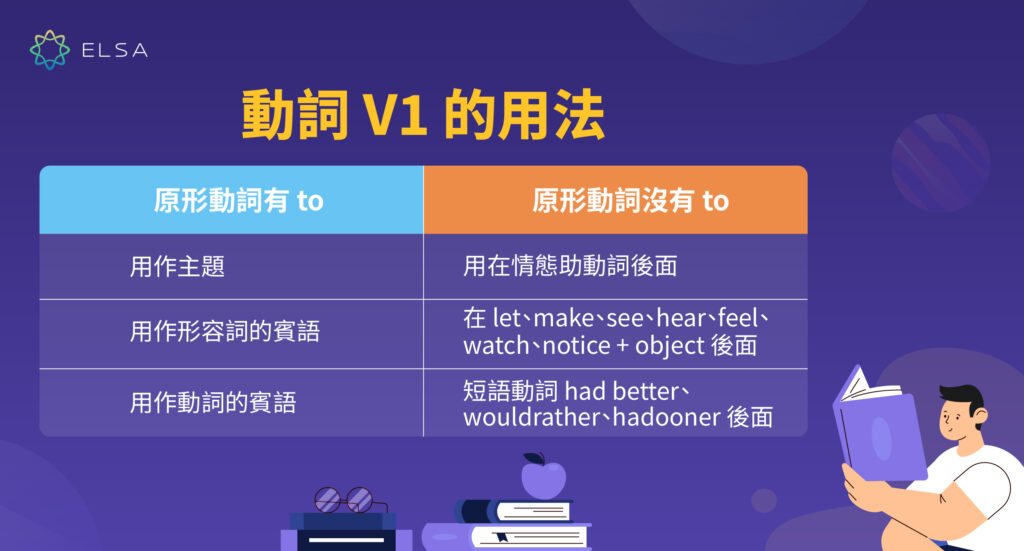
動詞三態英文中,這是動詞的基本形式。有 3 種符號方法: V1、V、V0 是表示不定動詞形式的符號 (infinitive verb).
這種形式用來表達一般的動作和狀態,不依賴任何具體的時間。
例如:
- Watch /wɒtʃ/
- See /siː/
- Push /pʊʃ/
- Go /ɡoʊ/
- Eat /iːt/
- Speak /spiːk/
- Write /raɪt/
- Read /riːd/
有 To 的不定式動詞 (to infinite)
| 用法 | 例子 | 翻譯 |
| 做爲主語 | To lean out of the window is dangerous. | 將身體探出窗外是危險的。 |
| 給主語補意 | Her dream is to become a doctor. | 她的夢想是成為一名醫生。 |
| 做動詞的賓語 | She wants to travel around the world. | 她想去世界各地旅行。 |
| 做形容詞的賓語 | I am happy to see you. | 我很高興見到你。 |
| 給名詞或代詞補意 | He has a plan to improve his English. | 他有一個提高英語水平的計劃。 |
| 在間接引語中 | She asked him to help her. | 她請求他幫助她。 |
| 用來代替關係子句 | There is a lot of work to do. | 還有很多工作要做。 |
| 用在名詞或不定代名詞後表達目的或已預期結果 | He needs someone to talk to. | 他需要有人傾訴。 |
| 用在too 和 enough后 | – The coffee is too hot to drink – The coffee is not cool enough to drink. | – 咖啡太熱了,喝不了– 咖啡不夠涼,無法喝。 |
| 用於感嘆或表達夢想的句子 | To think that he could have won the prize! | 沒想到他居然還能得獎! |
沒有 To 的不定式動詞 (bare infinitive)
| 用法 | 例子 | 翻譯 |
| 用在情態助動詞後 | You must go now. | 你現在必須走。 |
| Let, make, see, hear, feel, watch, notice + 賓語等動詞后 | She made him do his homework. | 她讓他做作業。 |
| had better, would rather, had sooner 等動詞組的後面 | You had better leave now. | 你最好現在就離開。 |
| why 或者 why not 后 | Why wait? | 爲什麽要等待? |
| 在命令句中 | Stand up! | 站起倆! =>來! |
V2 動詞的定義和用法
V2 定義
動詞三態英文中,V2 或者 V-ed, 是英語動詞的過去形式。這種形式描述過去發生的動作。
列如 => 例如: Swam (游泳了), Drove (開車了), Bought (買了), Caught (抓了), Wrote (寫了), Flew (飛了), Took (拿了), Gave (給了),…
V2 動詞的用法
V2 動詞主要用於描述簡單過去式的動作和狀態
例如:
- I went to the supermarket last night.
翻譯: 我昨晚已去了超市。
- I watched that movie 2 months ago.
翻譯: 我兩個月前已看了那部電影。
V3 動詞的定義和用法
定義
動詞三態英文中,V3 或者 Vpp 是英語動詞的過去分詞形式。這種形式用於表達在另一個動作或已完成的動作之前發生的動作
例如: Eaten (吃), Fallen (摔倒), Found (找到), Known (知道), Lost (丟), Made (做), Ridden (騎), Run (跑), Said (說), Sold (賣), Sent (寄/發),…
用法
| 用法 | 例子 | 翻譯 |
| 用於完成時態 | I have lived here for 2 years. | 我在這裡住了兩年了。 |
| 用於被動句 | The flowers were watered by my father. | 這些花是我父親澆水的。 |
| 用作形容詞,表示一個人對某個動作或事件的感受 | I was disappointed with the film. | 我對這部電影感到失望。 |
| 作為形容詞或壯詞,與被動動詞意義相同 | The police has found the stolen car. | 警方已找到被盜的汽車。 |
| 用於分詞組代替主語+被動動詞來連接或縮短具有相同主語的兩個句子 | 主動句: She enters. She is accompanied by her friend. 被動句: She enters, accompanied by her friend. | 她進來了。她由她的朋友陪同。她在朋友的陪同下進來了。 |
| 用於縮短關係子句 | Half of the people who were invited to the party didn’t turn up. => Half of the people invited to the party didn’t turn up. | 一半的受邀者沒有來參加聚會。 |
| 用於第三類條件句描述過去不真實的動作 | If I had known you were coming, I would have baked a cake. | 如果我知道你要來,我就會烤蛋糕了。 |
>>閲讀更多:

區分動詞三態 英文
英語的動詞三態式很容易區分。你可以查看下面的匯總表來了解這一點。
| 動詞形式 | 定義 | 用法 |
| V1 | 不定式 | 描述大概的動作 |
| V2 | 過去式 | 描述過去的動作 |
| V3 | 過去分詞式 | 描述在另一個動作之前發生的動作 |
>>精彩内容:所有關於八種英文詞性:用法、例子及在句子中的位置
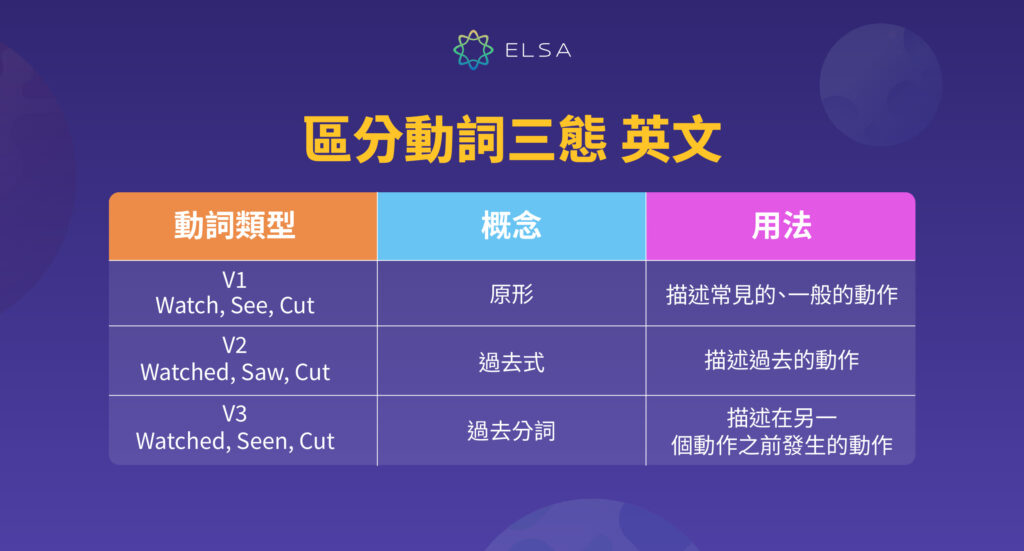
規則動詞和不規則動詞
英語中動詞主要有兩種:規則動詞和不規則動詞。這兩類動詞在V1、V2和V3詞形之間有不同的變化方式。因此,你需要了解哪些動詞是不規則動詞,並遵循規則才能正確使用它們。
規則動詞
規則動詞是指在不定詞 (V1) 上加上 -ed 形成簡單過去 (V2) 和過去分詞 (V3) 形式的動詞。
例如:
| V1 | V2 | V3 | 意義 |
| play | played | played | 玩 |
| love | loved | loved | 愛 |
| stop | stopped | stopped | 停 |
你應該記住一些在動詞上加上 -ed 的規則:

- 以輔音結尾的動詞,元音在輔音之前,需要將最後一個音加倍後再加上ed
例如: clap – clapped, stop – stopped, snap – snapped
解釋: Stop → Stopped
解釋: 動詞「stop」以輔音「p」結尾,「p」之前是元音「o」。加上 “-ed” 形成過去式時,我們需要把最後的輔音 “p” 加倍為 “pp”,這樣“stop”就變成了 “stopped”。
- 以e結尾的動詞只需加上-d即可
例如: love – loved, dive – dived
解釋: Love → Loved
解釋: 動詞 “love” 以字母 “e” 結尾。當加上 “-ed” 形成過去式時,只需在詞尾加上 “-d”,而不加上 “e”,這樣 “love” 就變成了 “loved”。
不規則動詞
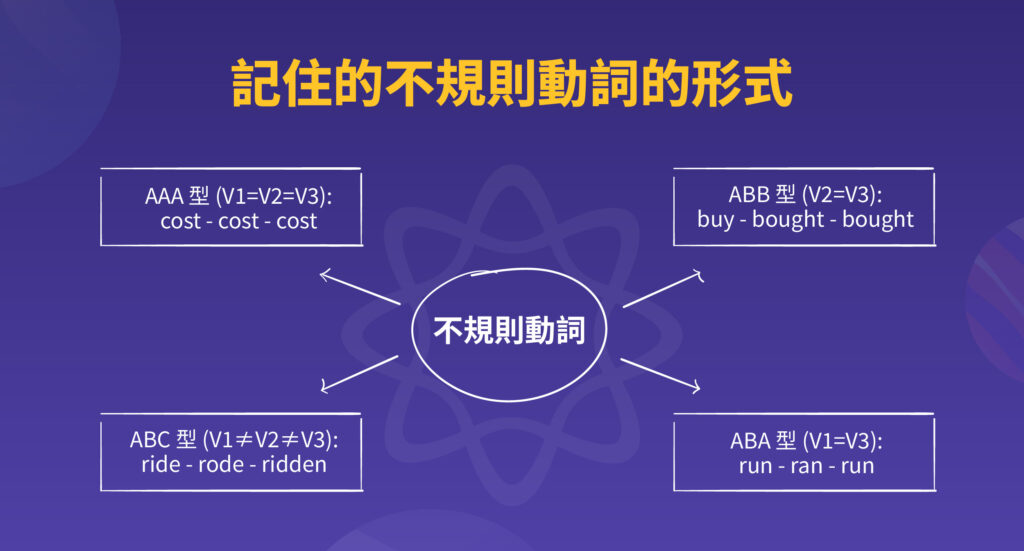
不規則動詞是由沒有任何一定規格的簡單過去式(V2)和過去分詞(V3)形式組成的動詞。英語中有大約 600 個不規則動詞,你應該知道至少 360 個最常見的不規則動詞。
AAA式的不規則動詞(V1=V2=V3)
| V1 | V2 | V3 | 翻譯 |
| cost | cost | cost | 費用 |
| cut | cut | cut | 切 |
| hit | hit | hit | 打 |
| let | let | let | 允許 |
| put | put | put | 放 |
| read | read | read | 讀 |
| set | set | set | 設置 |
| spread | spread | spread | 傳播 |
ABB式的不規則動詞 (V2=V3)
| V1 | V2 | V3 | 翻譯 |
| buy | bought | bought | 買 |
| sell | sold | sold | 賣 |
| hold | held | held | 組織 |
| tell | told | told | 說,講 |
| think | thought | thought | 想 |
| bring | brought | brought | 帶 |
| meet | met | met | 見 |
| keep | kept | kept | 保持 |
| sleep | slept | slept | 睡覺 |
| find | found | found | 找到 |
| seek | sought | sought | 搜索 |
| teach | taught | taught | 教 |
| spend | spent | spent | 花 |
| send | sent | sent | 發/寄 |
| stand | stood | stood | 站 |
| feel | felt | felt | 覺得 |
| catch | caught | caught | 抓/趕 |
| hear | heard | heard | 聼 |
| build | built | built | 建造 |
ABC式的不規則動詞 (V1≠V2≠V3)
| V1 | V2 | V3 | 翻譯 |
| ride | rode | ridden | 騎 |
| drive | drove | driven | 開車 |
| shake | shook | shaken | 搖 |
| choose | chose | chosen | 選/選擇 |
| break | broke | broken | 弄破 |
| speak | spoke | spoken | 說 |
| write | wrote | written | 寫 |
| eat | ate | eaten | 吃 |
| fall | fell | fallen | 掉 |
| forget | forgot | forgotten | 忘 |
| begin | began | begun | 開始 |
| drink | drank | drunk | 喝 |
| know | knew | known | 知道 |
| fly | flew | flown | 飛 |
| go | went | gone | 走 |
| see | saw | seen | 看/看到 |
| grow | grew | grown | 長大 |
| swim | swam | swum | 游泳 |
| do | did | done | 做 |
ABA式的不規則動詞 (V1=V3)
| V1 | V2 | V3 | 翻譯 |
| run | ran | run | 跑 |
| come | came | come | 到 |
| become | became | become | 成爲 |
| overcome | overcame | overcome | 越過 |
動詞三態的例子
規則動詞的例子
| V1 | V2 | V3 |
| I play piano every week. 翻譯: 我每週都會彈鋼琴。 | I played the piano yesterday. 翻譯: 我昨天彈鋼琴了。 | I have played the piano for many years. 翻譯: 我彈鋼琴很多年了。 |
| He is studying for the test. 翻譯: 他正在為考試而學習。 | He studied for the test last week. 翻譯: 他上週為考試而學習。 | He had studied for the test before the exam started. 翻譯: 他在考試開始前就已經準備好了。 |
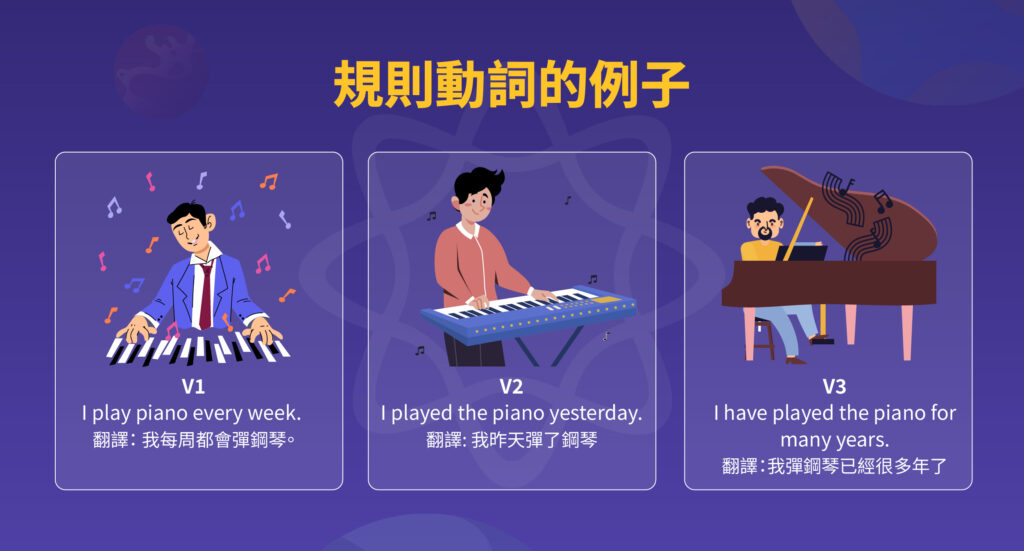
不規則動詞的例子
| V1 | V2 | V3 |
| I go to the park every Sunday. 翻譯h: 我每個星期天都會去公園。 | I went to the park last Sunday. 翻譯: 上週日我去了公園。 | I have gone to the park many times. 翻譯: 我去過公園很多次了。 |
| She eats breakfast at 7 a.m. 翻譯: 她早上7點吃早餐。 | She ate breakfast at 7 a.m. yesterday. 翻譯: 她昨天早上7點吃了早餐。 | She has eaten breakfast already. 翻譯: 她已經吃過早餐了。 |
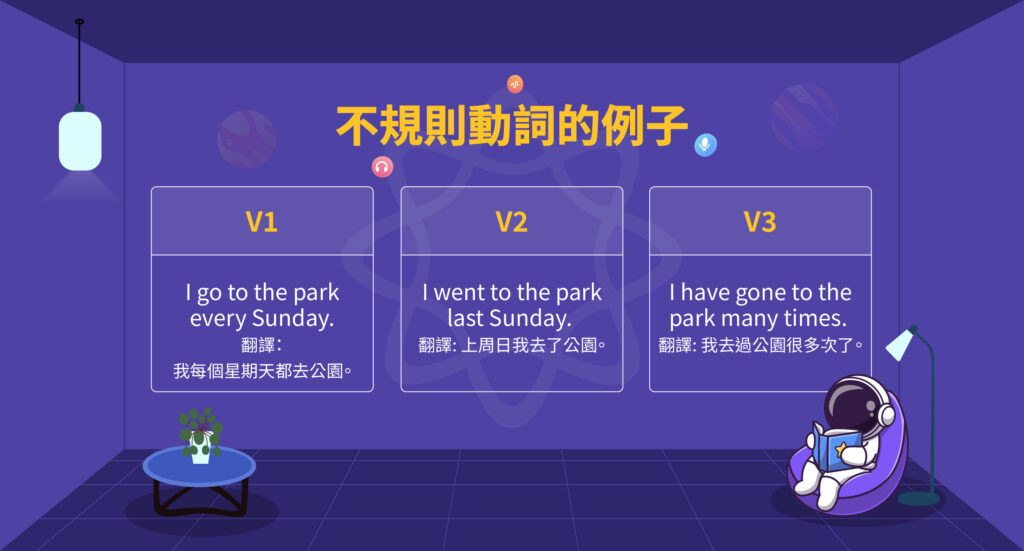
如何有效學習英文的動詞三態?
以下是 ELSA Speak 推薦的動詞三態英文學習方法,大家可以應用試試:
透過動詞組來學習
您可以應用規則動詞表來更好地記住動詞三態 英文。將它們分成具有相似特點的動詞組,這樣將幫助您比單獨學習每個單字更好地記住。
請參考如何將動詞分為以下 4 組:
- 第 1 組:具有 3 個相似形式的動詞(AAA 形式)。例如: hit – hit – hit
- 第 2 組: 具有相同的不定式和過去分詞形式的動詞(ABA 形式). 例如: become – became – become
- 第 3 組: 具有相同的過去式和過去分詞形式的動詞(ABB 形式). 例如: bring – brought – brought
- 第 4 組: 有3種不同形式的動詞 ( ABC 形式). 例如: awake – awoke – awoken
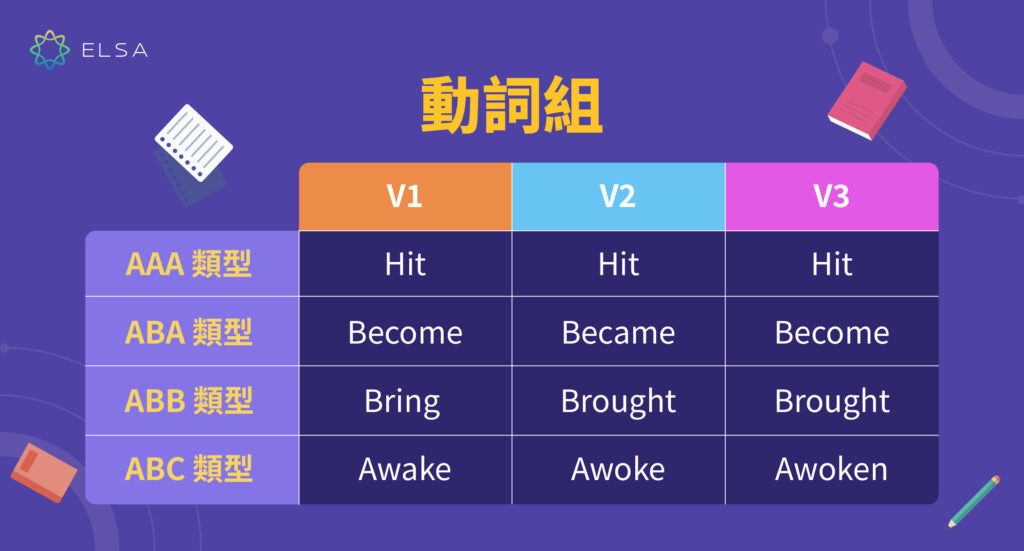
定期復習
要記住所有這些動詞,您可以使用 Spaced Repetition 方法。這意味著,例如,今天你學習了10個單詞,你將在1天、3天、7天、2週後複習這10個單字……第二天你重複這個過程。這有助於詞彙逐漸滲入記憶並使其難以忘懷。為了讓記憶更有效,你可以將 Spaced Repetition 方法與英語學習應用程式 ELSA Speak 結合。
該應用程式不僅可以幫助你科學地複習詞彙,還提供「課程集」功能,幫助你在「建立新列表」中創建自己喜歡的單字列表,並在「我的列表」中反覆練習。你也可以從 ELSA 學生創建的現有字典清單中探索和了解更多資訊。因此,你可以根據個人化的 Spaced Repetition 時間表練習詞彙、語法和發音技巧,確保你記住地更久、發音地更準確。
應用造句
應用造句是記住和理解如何使用動詞三態的重要方法。當你自己創建完整的句子時,你不僅可以學習動詞形式,還可以了解語境以及它們在現實生活中的使用方式。從簡單的句子開始,然後逐漸建立更複雜的句子,以測試你使用動詞形式的靈活性。這種練習不僅可以幫助你記住動詞,還可以幫助你在日常交流中流利地應用動詞。
例如:
- I go to school every day. (V1: Go)
- Yesterday, I went to the market. (V2: Went)
- She has gone to the store. (V3: Gone)
>>更多學習方式:2025 年幫助你在家最有效地學英文的秘訣

不要錯過具有大量功能的英語學習包
ELSA Premium 終身 – 最優優惠
原價:9,450元 現在 4,805 元
ELSA Premium 還有另外以下的學習包:
ELSA Premium 一年:原價:6,150元 現在 2,192 元
ELSA Premium 三個月:原價:2,100元 現在 1,100 元
動詞三態的練習
練習一: 使用 V2 動詞完成下列句子。
1. She_____(go) to the park yesterday.
2. She ______(not like) the food at the restaurant.
3. The movie __________(start) before I arrived.
4. The house ________(build) in the early 20th century.
5. I ________ (used to) live in a small town.
答案
| STT | 答案 |
| 1 | went |
| 2 | didn’t like |
| 3 | had started |
| 4 | was built |
| 5 | used to live |
練習二: 將下列主動句轉換為過去式被動句。
1. John wrote a letter.
2. They cooked dinner last night.
3. She bought a new car.
4. We visited the museum yesterday.
5. The teacher gave us a test.
答案
| STT | 答案 |
| 1 | A letter was written by Jotin |
| 2 | Dinner was cooked by them last night |
| 3 | A new car was bought by her |
| 4 | The museum was visited by us yesterday |
| 5 | We were given a test by the teacher |
練習三: 將括號內的動詞變位以完成句子
1. I (eat) breakfast at 7 am every day.
2. She (work) hard to finish her project at the end of week.
3. The children (play) in the park all day long.
4. I (go) to the movies last night.
5. He (see) a beautiful girl at the park.
6. They (make) a delicious cake for my birthday last month.
7. I (take) a picture of the beautiful sunset.
8. She (come) to my house yesterday.
9. I (be) born in Hanoi.
10. They (have) been to the beach many times.
答案
| STT | 答案 |
| 1 | I eat breakfast at 7 a.m every day. |
| 2 | She has worked hard to finish her project at the end of the week. |
| 3 | The children play in the park all day long. |
| 4 | I went to the movies last night. |
| 5 | He sees a beautiful girl at the park. |
| 6 | They made a delicious cake for my birthday last month. |
| 7 | I take a picture of the beautiful sunset. |
| 8 | She came to my house yesterday. |
| 9 | I was born in Hanoi. |
| 10 | They have been to the beach many times. |
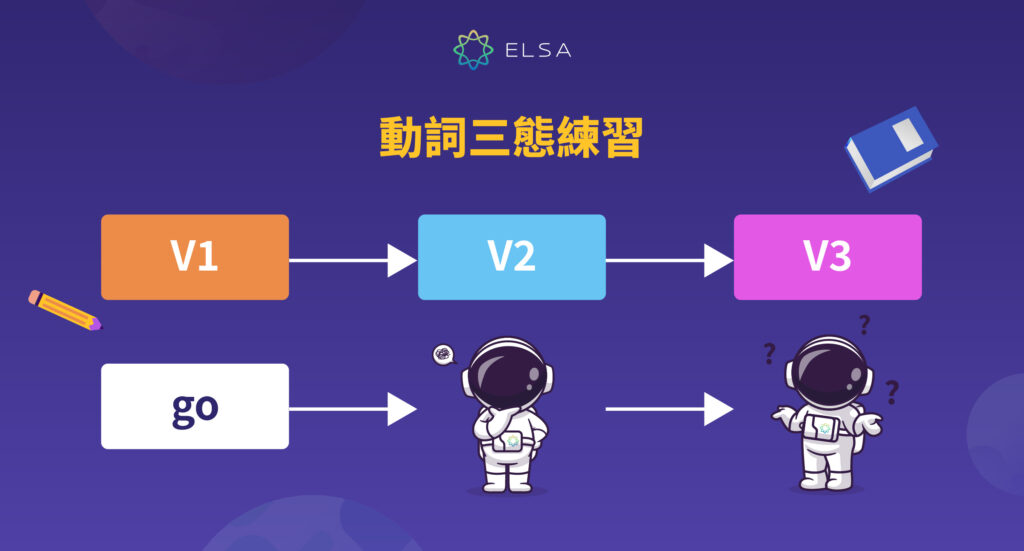
ELSA Speak 希望以上文章能幫助你更瞭解英文中的動詞三態是什麼,動詞三態表以及動詞三態變化整理表。請繼續關注 ELSA Speak 的下一篇文章就在英語文法專欄等你哦!


 2024年/09月/18日 | Linh Chau
2024年/09月/18日 | Linh Chau